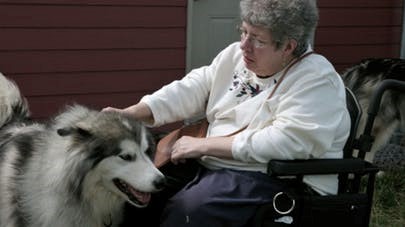To train a therapy dog, one must teach basic obedience and socialization techniques and obtain certification from an organization of qualified therapy dogs. Therapeutic dogs are not service dogs, trained to help people with disabilities.
Rather, they are pet dogs that visit a variety of facilities, including libraries, retirement homes and schools, to bring affection and joy to residents and children.
Although you can train yourself a therapy dog, many pet therapy organizations require proof that your dog has passed a standard skill test. Therefore, if your dog has the right temperament, you can brighten many people’s day.
Table of Contents
How to train a therapy dog
Treatment dogs must love people and have good manners. Also, this means that we must not jump on people, no needless barking, no food theft and no hyperactivity.
Most programs do not allow dogs under one year of age to participate. This is an excessive stimulation for these teenage dogs. When visiting a facility, be it a hospital, school or retirement home, a therapy dog should be clean and neat.
Train dog to be therapy dog – Basic requirements
Different programs for therapy dogs have different requirements, but some basic rules apply at all levels.
Your dog must be up-to-date with all vaccines – he goes to hospitals and other facilities that contain people with compromised immune systems.
If he receives some veterinary care, including treatments for fungal infections or drugs that suppress his immune system, he will not be able to participate until he is well.
So a dog with a history of biting or other aggressive behavior cannot be qualified as a therapy dog.
Also, dogs who have received Schutzhund protection training cannot participate in the therapeutic certification program run by Pet Partners, one of the largest pet therapy organizations in the country.

Therapy dog training course
Dogs therapy programs, community organizations, humanitarian societies, and dog trainers offer certified pet therapy courses.
In these classes, your dog is introduced to scenarios he may encounter while visiting a hospital or retirement home.
This could include presenting it to people in wheelchairs, hospital beds, and other situations.
Depending on the route, you can visit an establishment to gauge your dog’s reaction. At the end of the course, your dog is evaluated. Thus if he passes, he receives certification as a therapy dog.
How to train your dog to be a therapy dog
How to Become a Therapy Dog Trainer Therapy dogs allow people to interact with soft, loving dogs during times of stress or isolation.
Institutions such as hospitals, retirement homes, schools and even prisons use therapeutic dogs to calm patients, students and others who live in difficult places.
A therapy dog must have a gentle and patient temperament, but a good workout also plays an important role in the development of a good therapy dog. Dog trainers bring new dogs into this rapidly growing field of therapy
Emotional support dogs
The use of animals for therapeutic purposes is a growing activity.
Also, there are numerous studies and various investigations attest with conviction the benefits of these creatures.
Indeed, animals can improve the physical, mental and emotional health of people.
Perhaps it is thanks to their proximity to men that dogs are ideal for achieving this goal. Here are some explanations about canine therapy.
Dogs heal us

Dogs therapy seeks to improve the physical, psychological, but also the cognitive and social aspects of patients. Therefore, the dogs become a means of communication between the therapist and the people.
How is it possible? It is well known that dogs give us love unconditionally, they do not judge us, do not discriminate us either. So they are the opposite of what some of our peers do.
This last point is fundamental for people who feel vulnerable because of their physical, mental or emotional condition. Dogs do not pay attention to such details that end up causing rejection in some humans. Thus, patients feel safe when in contact with animals.
Both patients and dogs are under the supervision of a professional who helps in the recovery process of treated people.
Dogs bring a lot of benefits to humans. They help to treat us when we are going through difficult times, whether these problems are related to physical, mental or emotional health.
What a therapy dog does?

The treatment can be performed in different contexts and be offered in for a person or group form.
What is certain is that when the patient interacts with the dog, he or she forgets their pain for a certain time. Thus, the dog generates a positive change in his routine.
The benefits of this therapy have been demonstrated for a large number of pathologies, for example:
- Alzheimer
- autism
- Incurable diseases, mental or coronary
- Cerebral palsy
- Behavioral disorders
The positive effects seem to be most visible in children and the elderly. However, these therapies have achieved excellent results in rape victims and inmates who are thus benefiting from some form of social reintegration.
The benefits of training dog to be therapy dog
Among the successes of this assisted therapy with animals we can mention:
- Progress on motor skills and balance.
- The development of verbal interactions between members of the same group.
- Increased attention and concentration
- Better self-esteem
- Enrichment of the vocabulary.
- Reduced level of anxiety and loneliness.
- Improved memory.
- Dogs that help vulnerable teenagers
If it does not work, they make you forget it. It was the words of one of the young people about dogs participating in the program. Therefore, these dogs aim to act as a catalyst – or as a mirror – of the fears, anxieties, concerns and sorrows of adolescents.
Among the terrible stories told was that of a migrant who lost his family during the crossing between Africa and Europe and that of a young boy who lost his legs as a result of an accident.
For this type of case, dog participation is fundamental. Also, it helps to overcome the painful events that these young people have had to go through.
Dogs do us good and we must give them back
Since the destinies of men and dogs have crossed, they have not ceased to do us good. Thus, they are and will remain our saviors again and again.
However, our attitude toward them is not always right. Also they sometimes have to deal with human violence: we abandon them, exploit them, strike them …
Nevertheless, they remain with us and are faithful to us. Thus, it is we who should take the example of dogs and try to become better people in the process.
Even though, The support dog is intended to provide psychological assistance to a person under stress or in an unstable emotional state, they do help a lot. Thus, he is employed in areas such as justice, medicine, psychiatry or the police.
Comfort dog training

There is growing recognition of the beneficial effects of dogs on humans, both physically such as regulating heart rate and blood pressure, as well as psychologically and emotionally.
It is often said that the dog acts like a sponge; better than that he is able to “feel” them, in the true sense of the word.
Also, the man gives off odors thanks to the hormones that he produces, perfectly perceptible by the dog’s subtle sense of smell. He is thus able to know if a woman is pregnant or not and to detect certain types of cancers.
Thousands of years of dog domestication have made him the safest and most faithful of man’s allies. Indeed this is not a vain formula; the dog reassures a person when he feels stressed or destabilized.
It also acts in a more passive way, building the social bond and ensuring a role of derivative in stressful situations.
Conclusion
In conclusion, therapy dogs are important in the lives of many people. They help many people in many aspects.
To know more about how to train dogs to sit, check How to Train Your Dog to Sit on Command in Simple Steps.

